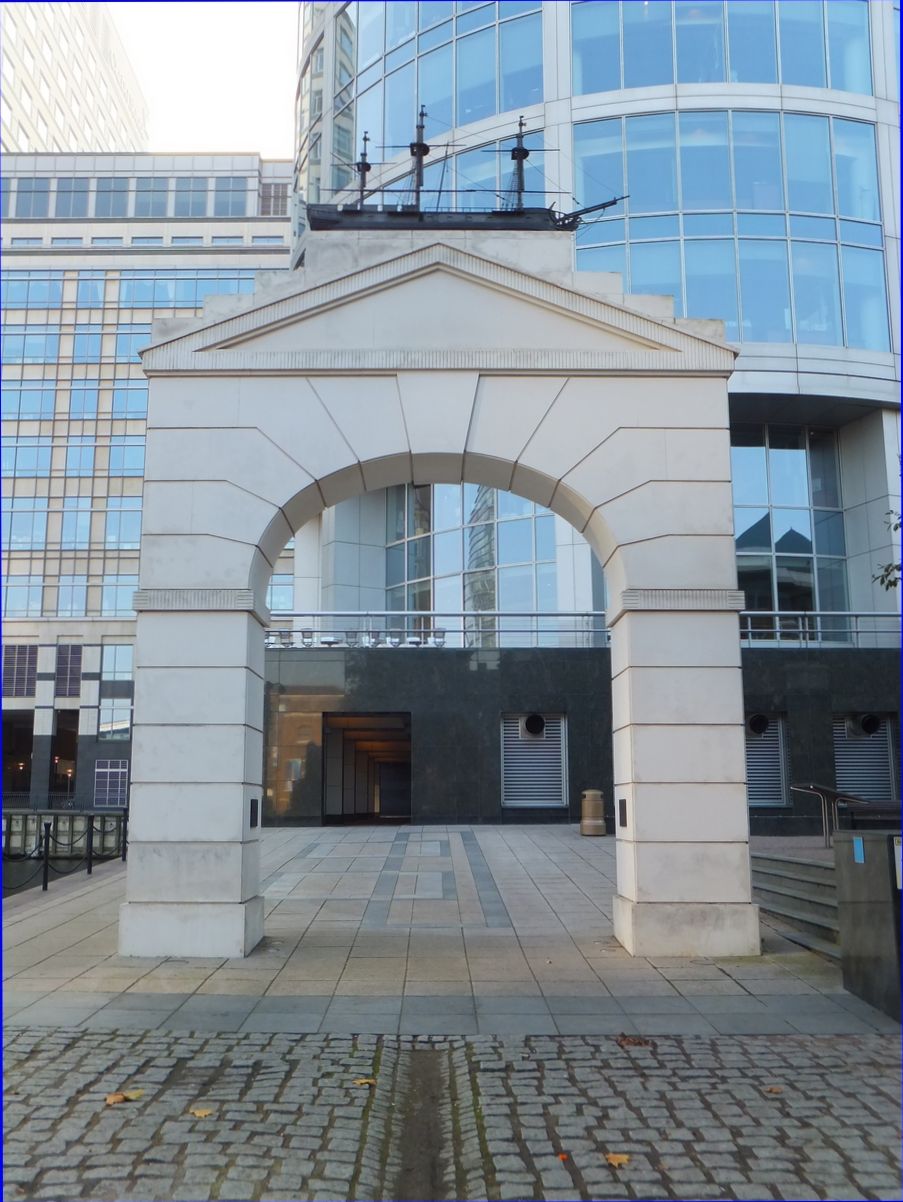 The original Hibbert Gate was built as the principal entrance at the west gateway in 1803. It was made of a Portland Stone arch surmounted by a pediment with a 10 feet long model of a West Indiaman ship called ‘ The Hibbert’ which was made of Coade Stone. This striking entrance became the emblem of the West India Docks and later formed part of the coat of arms for Poplar Borough Council. However despite its historical significance, in the 1930s it was decided that the entrance was not wide enough for modern vehicles and was to be demolished.
The original Hibbert Gate was built as the principal entrance at the west gateway in 1803. It was made of a Portland Stone arch surmounted by a pediment with a 10 feet long model of a West Indiaman ship called ‘ The Hibbert’ which was made of Coade Stone. This striking entrance became the emblem of the West India Docks and later formed part of the coat of arms for Poplar Borough Council. However despite its historical significance, in the 1930s it was decided that the entrance was not wide enough for modern vehicles and was to be demolished.
Although there seemed little opposition to the destruction of this historic entrance, a newspaper reporter at the time questions ‘the price of progess’.
THE PRICE OF PROGRESS. 1932
"Construction and destruction go hand in hand with progress in London, as in every other great city. Symbols of modernity rise almost daily on the ruins of old landmarks, which, were it not for the feverish hand of man, would withstand the stress of time and weather indefinitely. We are now told that the Clock Gate at the famous West India Docks, having outlived its usefulness and become a nuisance to traffic, must come down -is, in fact, already being demolished. Thus will disappear a landmark which, for 130 years, has served to turn the minds of Londoners back to that auspicious day when Pitt laid the foundation-stone of “the most magnificent dock in the world.” What the “most magnificent dock in tne world” mean’t in 1802 can be realised from the fact that the vessels to be accommodated in the West India Docks were put down at 300 tons each. The import dock, which is part of the West India Docks, could hold 204 ships of such size, but, judged by modern standards, it would be considered, of course, quite a puny affair. In this romantic dock there are several reminders of the age when men went down to the sea in sailing ships of the graceful clippers that rode the bounding wave. There is, for example, an ancient guardhouse, with two massive iron-cased pillars nearby to deflect the jib-booms of ships and prevent their damaging the adjacent warehouse or walls. There is too, a tall iron post surmounted by a bell which is still rung as a signal for fires and the extinguishing of all lamps and candles On the centre arch of the old gate way the eye was wont to behold a fine model in artificial stone of an East Indiaman named “The Hibbert.” Alderman Hibbert was principal director of the Docks Company, and, strangely enough, although his name had been forgotten in that association, It was preserved on the counter of this model, which measured about ten feet in length. In “The Peep show of the Port of London.” Mr. Linney says that “The Hibbert” underwent much overhaul, from time to time, and had a lead covering laid over her to preserve her from the destroying influences of the London climate. Her rig was somewhat queer, but the explanation was given that the dock master’s autocratic powers compelled a ship to submit to many things when once it had entered this “fortress dock.” Now, we hear, the model is to be given to the Poplar Borough Council, and will be re-erected in the Poplar recreation ground, where the modern generation will probably wonder what on earth it is."
The model was placed in Poplar Recreation Ground , however a combination of vandalism by the ‘modern generation’ and bomb damage left the model in poor condition. A last effort to save it failed, when the model collapsed in pieces whilst an attempted removal to Poplar Library.